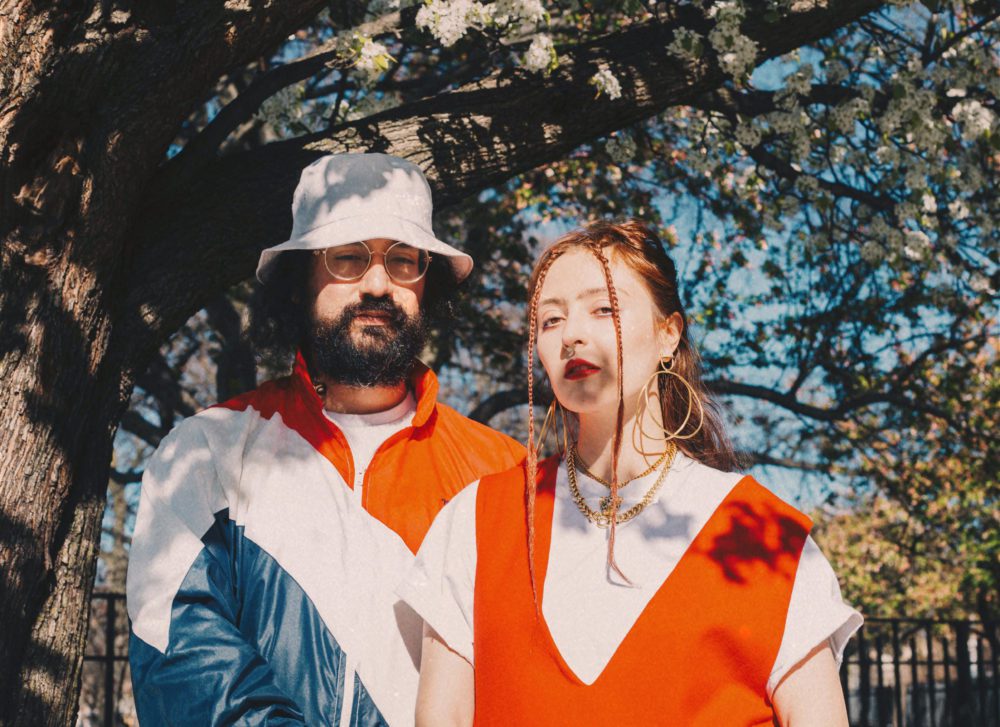Salt Cathedral Infuse Full-Length Debut Carisma with the Magic of Colombia


Salt Cathedral is more than a name for the New York-based duo of Juli Ronderos and Nico Losada. “It’s an umbilical cord,” says Ronderos by phone. The actual Salt Cathedral of Zipaquirá is an underground church, built in a salt mine about an hour outside of the duo’s shared hometown of Bogota, Colombia. “It’s our heritage, especially as someone from Bogota,” says Losada. “Kids from Bogota would go to the Salt Cathedral, the mine, and it was really awesome,” he explains. The two describe the monument, from the smell of sulfur to the darkness inside the space, as “magical.”
“Since Colombia is a Catholic country and it was a dangerous job, all the miners started doing shrines to the Virgin. We have many different virgins in Colombian culture that people pray to,” Ronderos explains. “It ended up being that the entire entrance to this mine was filled with shrines and they were religious.”
And, Losada says, Salt Cathedral is a name that reminds them of home. Ronderos and Losada left Colombia about a decade ago and met in Boston while they were students at Berklee College of Music. In 2012, they moved to New York and have been steadily making music, all the while exploring their interests and learning as they go.
On May 8, Salt Cathedral releases their debut full-length, Carisma, on Ultra Music. The dance-pop duo has been at work since 2013, having released a handful of EPs and singles, including last year’s collaboration with Big Freedia and Jarina DeMarco, “Go and Get It.” Over the years, they’ve also worked with dub legend Lee “Scratch” Perry, dancehall DJ Assassin, famed drummer Jojo Mayer and the singer Matisyahu. On Carisma, they collaborate with vocalists MC Bin Laden and duendita on the track “How Beautiful (she is).”
Losada and Ronderos say that it’s important for them to work with artists with distinct, specific sounds. “They do their thing and we do our thing,” says Losada. “We don’t want to collaborate with another producer or with somebody who sounds like Juli or writes like Juli. We want to collaborate with someone who can bring something else to the table.”
For the duo, making music together has been a long journey of self-discovery. The two have quite different musical backgrounds. Losada started playing classical guitar as a child and gravitated toward hardcore and metal in his teen years. It’s music he appreciates now more for the energy and message. “I love Minor Threat, not because of the music, but because of what it symbolizes – that freedom of being yourself,” he says.
Ronderos, on the other hand, didn’t have much exposure to music growing up. “I grew up almost without music. My parents don’t really listen to music,” she says. It wasn’t until later in her teens that Ronderos gravitated to jazz and began studying it on her own. Both ended up at Berklee College of Music. “There were a lot of great musicians around us,” says Losada. “People were practicing ten hours a day and people were taking it very seriously.”
After finishing school, they headed to New York. “It was a different kind of world,” says Ronderos. “All of our classes were about jazz composition, writing, orchestrating and improvising. We had never produced or recorded really. We started a band in college, writing our own songs. We had only done it for a year.”
Starting out in a new city, without the community of potential collaborators that they had in college, meant that they were on their own. They learned how to make electronic music and record themselves. “That was a really big transition,” Ronderos recalls. They wrote new songs. Ronderos recorded the vocals herself. Losada mixed the tunes. It took them a while, Ronderos says, to really come to understand what they were doing. “We were fearless and we started doing everything ourselves and started making it work,” adds Losada. At the same time, they were also asking themselves, “What are we trying to say? What are we trying to develop?”
Carisma, then, is an exploration of who they are, where they’ve been, and where they are now. “We went through this process of discovering that super-Latino side of us that wants to dance and move to music in an uplifting way,” says Ronderos. “This music [comes from] a period in our lives when we were exploring that.”
In the weeks leading up to the album release, though, Salt Cathedral has gone through another period of exploration. “We can’t tour so we want to write more and be active and continue to create this world that we can create because we can’t go and play,” says Losada.
“We’re taking advantage of the time and the fact that we’re very self-contained,” says Ronderos. “We can make music at home. We have our instruments and we can record.”
They’ve been working on writing their next album; additionally, they’re trying to work on a “re-imagination” of Carisma, what Ronderos calls an “isolation mix” influenced by how they’ve been experiencing music while staying at home. Says Losada, “It’s a crazy time and I feel like we’re not listening to music the way we were two or three months ago.” No matter what happens, Salt Cathedral keeps moving.
Follow Salt Cathedral on Facebook or Instagram for ongoing updates.




